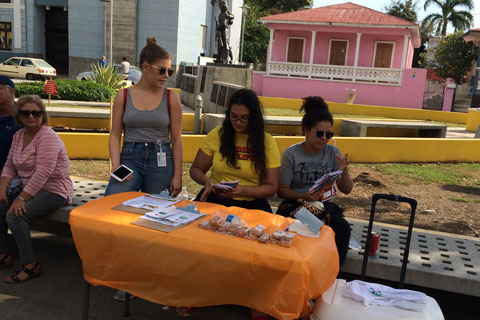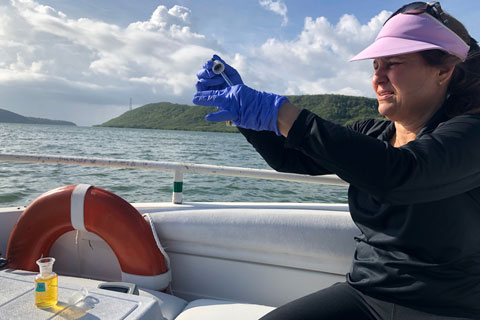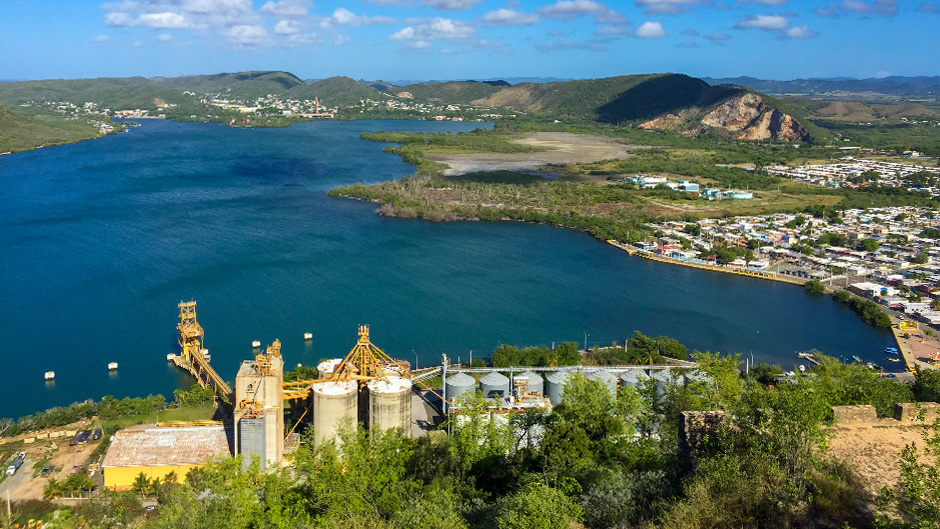Residents of Guánica, Puerto Rico, have long known about the troubled past of pollution that has plagued the waters of the small inlet situated off their town’s southern coast.
Edgardo Cruz, a retired U.S. Air Force lieutenant colonel who grew up in this town of more than 16,000, can recall vividly the story his father told him about the tanker that spilled thousands of gallons of oil into the bay nearly 60 years ago, turning its waters black.
“He was a fisherman and had to go miles and miles offshore just to make his living,” Cruz recalled. “The waters were too polluted.”
Other residents, especially the elders, remember how the town’s fertilizer plant used to produce ammonium sulfate and sulfuric acid in the 1950s and 1960s, dumping its untreated waste into the inlet.
Today, Guánica Bay is once again at the center of a contamination crisis, and a University of Miami scientist is helping to bolster efforts aimed at abating the problem.
“Raising awareness is just part of the solution,” said Naresh Kumar, a professor of environmental health in the Miller School of Medicine’s Department of Public Health Sciences, who, since 2014, has been tracking and documenting elevated levels of a group of harmful chemicals called polychlorinated biphenyls, or PCBs, in Guánica’s scenic bay.
“Scientific research and following the science is the key,” he said. “Without data, we cannot even begin to create educational awareness. So, our approach has been a holistic one. It’s about aiding community members who could be at risk, informing them what kinds of actions they can take to reduce their exposure.”
Seven years ago, Kumar and his team tested sediment samples from three locations in Guánica Bay, discovering that they contained the second-highest levels of PCBs ever recorded anywhere in the world. “Second only to those found in Canada’s St. Lawrence River in 1995,” Kumar said.
Their testing revealed PCB levels higher than those detected by scientists from the National Oceanic and Atmospheric Administration (NOAA), who analyzed sediment from the bay shortly before Kumar’s team.
He and his team members, who spent about a week in Guánica conducting research and public hearings on the contamination, also found high levels of PCBs in two species of fish—mutton snapper and common mojarra—that inhabit the bay.
Once valued for their stability and used as insulating fluids and coolants in electrical equipment such as transformers, PCBs were banned in the U.S. in 1979 because of their toxicity. But they can still be found in the environment because of their resistance to natural degradation and their bioaccumulation in the food chain.
In underserved municipalities like Guánica that lack both extensive resources to test for dangerous chemicals and the effective measures to clean them up, “PCBs can pose a serious public health threat,” Kumar said. “They can damage the immune and reproductive systems and the nervous system, as well. And exposure to them has been documented to cause cardio and cerebrovascular disorders.”
Since his team’s initial testing of sediment from the bay, contamination at the site has spiked. Two years after Hurricane Maria devastated the island in 2017, Kumar and his team returned to Guánica to conduct follow-up analyses of the sediment, finding that PCB levels had increased threefold. His hypothesis is that the storm’s powerful winds dredged the bottom of the bay, bringing up more PCB-contaminated sediment.

But it was what they found during a different kind of sampling that raised more serious concerns: elevated levels of the chemical in blood samples taken from 150 Guánica residents, which suggests some of the townspeople consumed fish from the bay.
If any location qualifies to be a Superfund site by the U.S. Environmental Protection Agency, it is the area surrounding Guánica Bay, according to Kumar. The Superfund program centers on cleaning up contaminated areas. And such a designation would force parties responsible for the contamination to either clean up the site or reimburse the government for EPA-led cleanup work.
But the agency, following the completion of the NOAA study, ruled that the site didn’t qualify as such, saying that no exposure pathways for humans were present.
Now, however, that may change. Last month, the EPA proposed to add the Ochoa Fertilizer Co. in Guánica to its National Priorities List, starting a “comment period” that will run through Nov. 8 and during which Guánica’s residents can voice their concerns.
“The EPA will not make a final decision on the site until it has reviewed comments received from interested stakeholders,” said EPA spokesperson Stephen McBay, who added that the agency’s next update on the Ochoa site is expected in March 2022.
The site at the Ochoa Fertilizer Co. consists of two parcels: a 13-acre western lot along Guánica Bay and a 112-acre eastern lot within 500 feet of the inlet. The facility’s former operators manufactured ammonia, ammonium sulfate, and sulfuric acid at the site beginning in the 1950s, ceasing those operations in 1968. Today, fertilizer is produced on the 13-acre lot.
But it is not the fertilizer or the chemicals that were manufactured there in the past that are to blame for elevated PCB levels in the bay, but rather generators that once produced electricity for the plant’s operations, theorizes Helena Solo-Gabriele, a professor of environmental engineering at the University of Miami’s College of Engineering. A member of Kumar’s team, she traveled to Guánica on two occasions to collect and test sediment from the bay.

“The energy needs of such a plant are substantial because, essentially, nitrogen from the air has to be combined with hydrogen gas to produce the fertilizer,” Solo-Gabriele explained. “It’s a very energy-intensive process. So, it is possible that there were once old PCB-insulated capacitors onsite that caused the contamination.”
Kumar’s team, however, has no evidence so far to back up that scenario. He pointed out that his team also detected other chemicals in Guánica Bay’s sediment, including arsenic and polycyclic aromatic hydrocarbons, a class of chemicals that occur naturally in coal, crude oil, and gasoline.
Whatever the EPA decides, Kumar and his team are determined to keep Guánica Bay’s PCB contamination issue at the forefront.
Not long after their initial testing of bay sediment, the team collaborated with Guánica’s Aurea E. Quiles Claudio High School to launch a public awareness campaign about the contamination in the bay. Students created posters listing PCB contamination rates and the potential impacts the chemicals could have on human health and the environment, and they went out into the community to distribute the information.
Some of those students later attended a summer training program at the University, learning about environmental issues and using portable biosensors designed by researchers in the Department of Biochemistry and Molecular Biology to test water samples for the presence of PCBs—knowledge they would later take back to their communities in Guánica, Kumar reported.
For one of those students, Michael Gambale, the issue hits close to home. His mother still lives in Guánica, and he has other family members there. “So, working on this project was like giving them a security blanket,” said Gambale, who is now a senior at the University of Central Florida and plans to return to Puerto Rico after he graduates.
“I could see the passion for the project in Dr. Kumar’s eyes when he was in Guánica, and that sort of rubbed off on all of us,” Gambale said.
Cruz, the retired Air Force lieutenant colonel, would like to see Guánica Bay restored to its former luster. He is the founder and owner of Guánica’s community library, La Casa Del Guaniqueño, and helped organize some of the community events that doled out information to residents about the bay’s contamination. Cleanup of the bay, he noted, could help transform his hometown into a major tourist hub, attracting more visitors and boosting an economy that has sometimes suffered.
He and other community partners recently participated in a teleconference call with Kumar to explore future outreach efforts now that the EPA is considering adding the Ochoa site to its National Priorities List.
“This endeavor is vitally important to us,” said one of those partners, Roberto Viqueira Ríos, executive director of Protectores de Cuencas, a Puerto Rico-based NGO (non-government organization) that focuses on ecological rehabilitation, green infrastructure, and sedimentation and erosion controls. “Guánica Bay is a priority conservation area for the U.S. Coral Reef Task Force, Puerto Rico’s government, and other organizations, and we plan to continue our collaboration with Naresh on outreach and education efforts.”
Kumar remains optimistic that the EPA will designate Guánica site as a Superfund location. “We’ve clearly shown that some children from the community swim in the bay and that some people are catching and eating fish from it,” he said. “So, there’s an obvious link to human exposure.”

